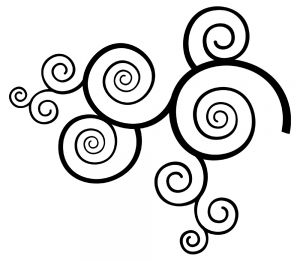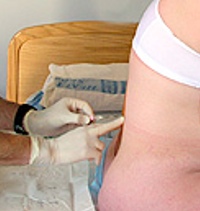Lately I have been asked a lot about pushing. Hypnobirthing advocates birth breathing and letting the uterus do the work of bringing the baby into the world. This one aspect of the program seems to cause much confusion and debate. Many doctors simply don’t believe that a baby can be born without active pushing. To which I respond, that just because you haven’t seen something, doesn’t mean that it doesn’t exist. Yes many women push their babies out. Yet other babies seem to float out into the world, while their mothers breathe down and let the surges of their uterus move the baby into the world. To me this seems the ideal way to allow a baby to be born. It conserves Mom’s energy. It allows both mom and baby to have a good consistent source of oxygen. It prevents pressure from building up in mom’s eyes or face, so no broken blood vessels. It allows mom’s body to do what it is designed to do. It allows the tissues of the perineum to stretch gently wide open and allows mom to give birth with the tissue of her tissue intact. It allows baby the gentlest entry into the world. Sounds good to me.
I will agree that there are special circumstances, like baby’s position, which may necessitate more active pushing. However I would hope that the gentler approach be used first and that any active pushing be done with an exhalation, as opposed to holding the breath, which is detrimental to both mom and baby. I believe it’s very important for mom to follow her own birthing instincts and to bear down when she feels the urge rather than pushing because someone else in the room is telling her too.
Today I came across this wonderful video on youtube of a hypnobirthing mom giving birth. The best part is the you can clearly see that she is allowing her surges to bring her baby into the world. What is ever better is the wonderful support that she gets from her midwife to encourage her to use her surges and to ease the baby out slowly and softly.
I hope that you enjoy this video as much as I did, and that it inspires you to breath your next baby into the world with ease and grace.
[youtube=http://www.youtube.com/watch?v=qriqhDFo088]
http://www.youtube. com/watch? v=qriqhDFo088
Marie
This topic can up again! Surprise Surprise (that’s me being sarcastic). Anyways. Here is some new information that might shed some more light on this debate. Now it’s a bit technical, but basically it supports what I have been saying all along…
Wait for your body to tell you to help move the baby out!
Incidentally there have been a number of studies that show that “laboring down” (waiting until the baby is on the perineum until mom is “told to push”) is better for moms and babies.
I would love you to take this information to your doctor and see what they have to say. 🙂
Marie
The Art of Midwifery
This technique is called a “Piskacheck, ” after the Russian obstetrician who started using it. An important thing to note is that classical midwifery classifies labor into more steps than modern midwifery does. Classical midwifery divides second stage into two steps: descent and expulsion. Midwives in Russia understand that once a woman is 10 cm dilated that doesn’t mean that she has to start pushing; they wait until the head is on the pelvic floor before encouraging women to push. This means that mother and baby don’t get exhausted, and pushing only lasts for an average of 10 minutes.
The Piskacheck technique is an assessment tool to tell where the fetal presenting part is, in order to know in which part of second stage the labor is. The midwife usually uses a piece of cloth or drape and, holding it in her dominant hand, she presses it with her index and middle finger on the outer side of the labia majora. If something firm is felt through the labia, then the presenting part is low! If nothing is felt, then the patient is encouraged to rest and breathe until the baby is lower in the vagina.
– Sharon Craig, Kabul, Afghanistan
Excerpted from “Tricks of the Trade,” Midwifery Today, Issue 78
View table of contents <http://www.midwifer ytoday.com/ magazine/ issue78.asp>
This is what Mickey the founder of Hypnobirthing had to say.
If the mom is in the relaxed state that she is meant to be in, she should, indeed, just relax and wait. The baby will soon be on the vaginal outlet with no effort on her part. Babies know the drill. She will feel the surges and feel the baby move to the outlet. Then she can bear down a bit and help him/her out. This is what our moms are saying when they tell us that it took only two birth breaths, and he was out.
Two moms just within the last three weeks (One was mine) have had this identical story, and I’m sure there are many whom we haven’t heard from. Actually, it was three moms if you count the mom who gave birth on the Southwest plane (Not HB, but she had an HB birth.) The doctor, who was sitting right behind her, said that she “pushed only a couple of times, and the baby was born.” He was a bit taken aback that it was so short.
Mickey Mongan





One thought on “To push or not to push… that is the question (pushing in labour)”
The whole principle of hypnobirthing is that you go with your body. The breathing and visualisation that you learn in class is a very effective way of birthing your baby which, as you say, can confuse midwives because it appears as if the mother is doing nothing. However, if you fell the urge to bear down, you go with it. It would plainly be creating tension in the body to go against it, and that’s the last thing you want to do.
Katharine Graves
Katharine Graves is a hypnobirthing teacher in London